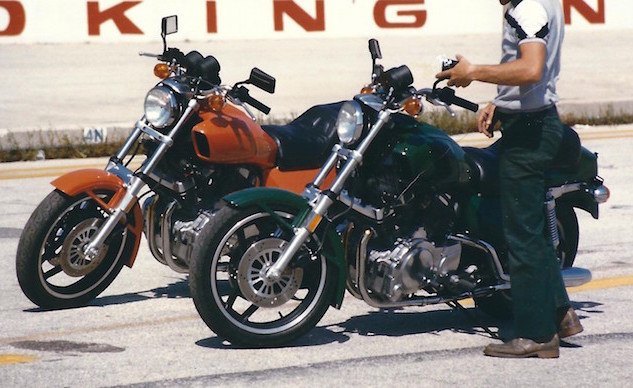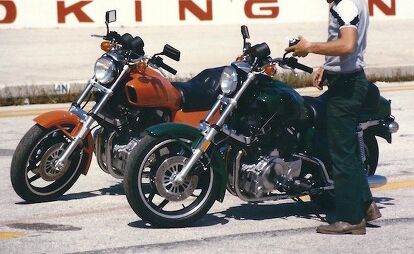Whatever: Hate Conquers All
Polarization is all over the news lately; there seems to be plenty of hate in many of the good people on both sides for the people on the other side, as the Black Lives Matter discussion – among other hot-button topics – continues to swirl. And there’s never been any better topic on MO, if the goal is to stir the pot, than Harley-Davidson. Saaay, why not combine the two?
When a MO reader, and aspiring MO contributor, approached us the other day with an idea for a story about Harley in the AMF days (mid 1970s), he reminded me of some things I’d put out of my mind long ago. As Harley struggles to reinvent itself (it was struggling for a while there until Matt Levatich got canned, anyway), this reader was interested in exploring a story about another time Harley wanted to go in a different direction. That would be the Project Nova road H-D started down nearly 50 years ago – a radical new direction for the company that would involve building a bunch of V-twin, V-four, and V-six modular engine powered motorcycles, with help from Porsche. Word is a V-4 touring model was the most completely developed Nova, with 130 fuel-injected horsepower, radiators fed by cooling ducts hidden under its bodywork, under-seat gas tank, shaft drive – all at a time when the Honda Goldwing was still kind of a big weird sportbike.
Obviously project Nova never happened, though this mock-up is proudly on display in the H-D Museum in Milwaukee. What happened instead is Willie G. Davidson and some others engineered a buyout of his namesake company back from AMF.
Even if they’d been inclined to stay on the Nova path, Harley didn’t have the millions it would’ve taken to tool up the factory and actually build Porsche motorcycles, on top of the millions AMF had already spent. We’ll never know if it was a genius move or a travesty to abandon Nova (good people on both sides of the argument) – but apparently the AMF bigwigs weren’t all rocket surgeons either. AMF Harleys were notoriously shoddy (that’ll get me some hate mail, and it should: Hearsay, your honor!), and AMF was reportedly over-extended in various ventures.
Wikipedia tells us: Unlike large Japanese corporations such as Matsushita Electric Industrial, which had a standing corporate policy of discontinuing any product line or division in which they were not able to stay in first or second place in total market sales, AMF continued a practice of purchasing new companies in unfamiliar markets, while simultaneously failing to reorganize and modernize its core operations. As a result, during the late 1970s and early 1980s, the company lost an average of US $8 million per year. Some subsidiaries were sold, including Harley-Davidson in 1981.
By 1985, American Machine and Foundry was kaput.
Post-AMF, it was time to get back to the core business of building traditional American motorcycles for traditional American motorcyclists, who can be somewhat resistant to change. What I’d blocked out of memory, and what I started out to write about when it got jogged, was just how resistant to change those guys were in the days when I was just starting to warm up to the idea that maybe riding a motorcycle on the street wasn’t as suicidal and ridiculous as everybody had always told me? I’d been subscribing to Cycle magazine for a year or two and was just figuring out the lay of the land when the issue with the new Virago 750 on the cover arrived in my mailbox. 1980?
As I recall it was a really positive review, but whoever wrote it, you could read between the lines, was kind of thinking he needed to hold back from praising the bike as much as he wanted to. There may have been a sort of preemptive defensive editorial up front also. When the reader feedback arrived in print two issues (two months! later), there was a lot of scathing mail, and this was in Cycle, the longhair literary sophisticate bike mag. I can only imagine the blowback at Easy Rider (which was in the dirty magazine section where I was too embarrassed to browse. When I was feeling brave, now and then I’d throw a Playboy in my cart, face down, but only if I was buying a bunch of other stuff).
It’s like, as long as the Japanese were building small bikes, or inline-Four bikes, or dirtbikes – or any kind of bikes that were nothing like our sacred American V-twins, it was cool. Everybody called them Japbikes then, or riceburners, before we knew at least the first term was offensive. The price was right. But the Virago was a V-TWIN! How DARE THEY!! It didn’t matter that the Yamaha V-twin was an overhead-cam one in a sporty bike (fully faired sportbikes were not yet a thing) with a monoshock rear end that looked nothing like a Harley. There wasn’t just anger, there was real hate. They’re coming for our women!
In 1980, people did at least have legitimate reasons to be fearful: The CB750 really had put a huge dent in the rest of the world’s already wobbly motorcycle industry only ten years earlier, and the Vietnam debacle, along with all the racial/culture wars it stirred up, had finally just ended in 1975. There were some bad hombres riding around my hood on their Hogs, people I did not wish to upset.
I first went to Daytona in the early `90s, and was surprised to see they were still burning Japanese bikes in effigy at select events, though it’s a thing I’d read about in the magazines for the previous decade. (I was surprised by a lot of stuff at that first Daytona.) In researching his story, our MO wanna-be contributor tracked down an engineer who’d worked at Harley and Buell (and other impressive places), and has a lot of fascinating information to share; I probably shouldn’t name him right now (or maybe ever) but here’s one anecdote:
There was a perverse patriotic loathing of Japanese motorcycles, even German bikes to a lesser degree. There were H-D employees that would not even eat Japanese food. Some of this had to be a victim response. One example was the promotion of the “Samurai Slam”: Dealers would stage fundraisers selling sledgehammer strikes to a Japanese bike for $1 per hit.
H-D bought two KZ1300 Kawasakis for analysis. One went on accelerated durability testing (bashing through an automotive durability course), and the second I used for cooling system evaluation, recording with about 25 thermocouples.
Later, my KZ went up for sale and I tried to buy it. Instead, it was sold to a Wisconsin HD dealer for his Samurai Slam. I went down to witness the carnage.
The KZ was hoisted to the dealership roof as the crowd cheered. The engine was cold-started and held at WOT, expecting engine failure. Never happened. The KZ was brought down, oil and coolant drained, then hoisted back to the roof. This time, WOT had the desired effect. They pushed the KZ off the roof and lit it on fire in the parking lot.
I wouldn’t even be surprised if stuff like this still goes on, but it’s not as common as it was 30 years ago. Like I mentioned in my Rebel 500 review last week, I was kind of surprised when a guy on a Dyna gave me a thumbs-up when we were stopped together at a light, but I guess I was only surprised because I’m old now. These days, Harleys, Japanese, Italian, German, Chinese and Indian bikes – both American and Asian – all happily coexist when I make it to Cook’s Corner on a weekend.
When Japanese cars got here about the same time this was all going on, my greatest-generation WW2 dad said no how, no way, NEVER! After driving a couple AMCs, a Plymouth Volare wagon – and it may have been the Chevy Vega my big sister bought for her first car that finally pushed him over the edge (now you’re messing with our women!) – he became a Toyota man unto death. I still respect his ability to change, but it was a slow, angry process.
Two steps up, one step back. In no way am I disparaging the current U.S. Harley-Davidson or automobile industries, which do produce some truly world-class vehicles. All I’m saying is the hate their foreign competitors had to slog through on their way to popular acceptance was totally wasted, and only contributed to lots of coronary thromboses for the haters and delayed gratification for the rest of us. Also, that competition with the rest of the world is what prodded the US industry into stepping up its game, leading to better things to ride and drive for all of us. Hate is fun for a while, but it seems to always lose in the end.
Is there a larger lesson for the world at large about embracing change? As Sgt. Jaime used to say so eloquently, anytime I asked if I could get a day off or a promotion or a filter for my gas mask: I DOUBT IT!
More by John Burns








































Comments
Join the conversation
Samurai Slam, never heard of such hateful act . . . it instantly reminded me of KKK assemblies and public black people lynching.
WTF is wrong with people ?🤔😞👎🏻
The Nova was belt drive, not shaft as you state. Look at the picture in the article!